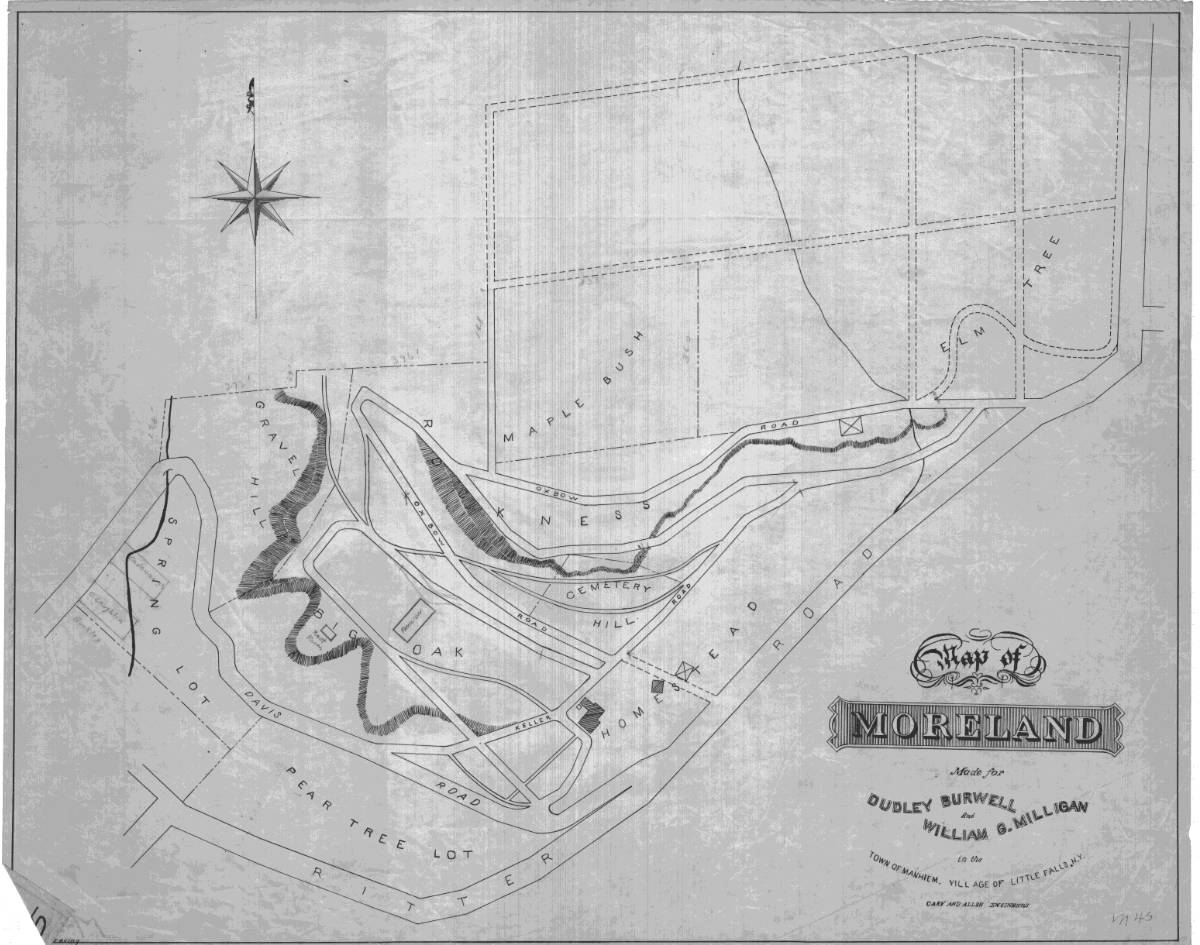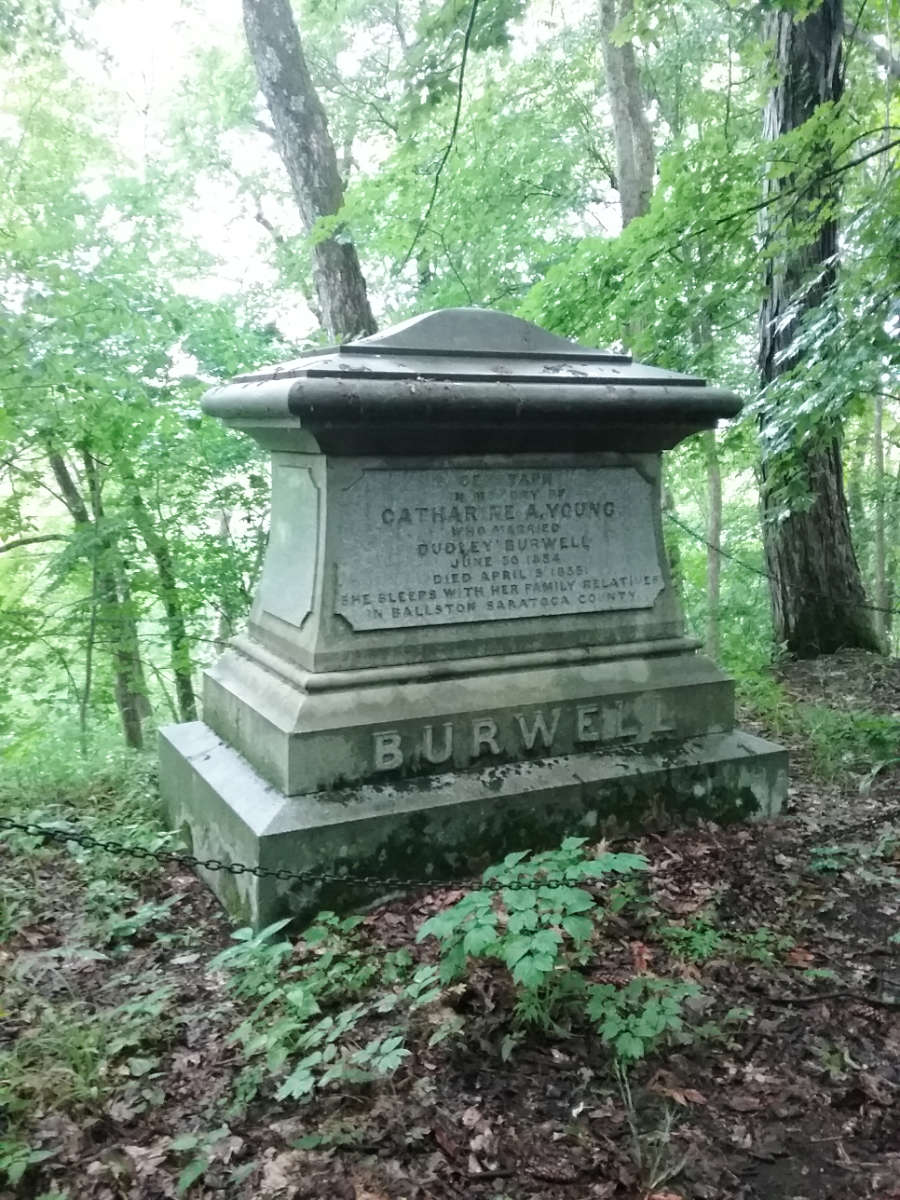On APRIL 18, 1876, Dudley Burwell, prominent Little Falls attorney and one-time member of the state legislature, died at his home in what is now Moreland Park.
“He donated the land for the park and is buried at the top-of-the-hill with his beloved dog.” Dudley had lived a full life since becoming the son of Nathan Burwell, Poland, NY’s first blacksmith. Dudley had his first paying job as a schoolteacher at the Dairy Hill School in Norway, before following a life of law, being one of the first attorneys to have been employed by the village of Little Falls and was also appointed the district attorney for Herkimer County in 1836.”
April 18, 1876, Cooney Archives
Are you interested in learning more about Moreland Park and the life of Dudley Burwell? Please view two very informative Little Falls Historical Society Museum’s WRITING SERIES articles, the “Little Falls Philanthropy” by Louis Baum and the “Burwell Street Namesake and Moreland Park Visionary ” by Jeffery Gressler.
AFTER THE DEATH OF DUDLEY BURWELL: A HILLSIDE HERMIT
A COLLEAGUE’S MEANINGFUL FAREWELL
Upon Dudley Burwell’s death, on August 18, 1876, a memorial was prepared and conducted in his memory at the Supreme Court, held at the Herkimer County Courthouse at Herkimer, NY, with eulogy remarks made by Judge Hardin, Hon. Ezra Graves, Hon. A. H. Prescott, Samuel Earl, Esq., and Judge Arphaxed Loomis, with the remarks recorded in the court minutes. Court was adjourned for the day, following the ceremony.
Arphaxed Loomis wrote Burwell’s obituary and stated that Dudley, amongst so many fine attributes, was also outspoken and critical, even of himself, with Burwell once stating, “much of my life has been wasted in artificial sorrow.” Burwell also stated about himself in his later years at Moreland, “I have lived 10 years previously without the slavery of business or pursuit. I was quite tired of this so-called world, and quietly slid out of its way and its society and found myself among these rocks, where probably I shall end my days.”
THE HERMIT OF BURWELL HILL
The eccentric, wealthy bachelor, Dudley Burwell, had lived a reclusive life at Moreland. Dudley had lost his wife, Catherine Ann Young in 1835, with less than a year of marriage. He grieved her loss deeply, with never to remarry.
Frances Ledyard Haun, a Victorian authoress, born in Little Falls in 1860, was the daughter of a long-standing Little Falls physician, Doctor Abram Haun. Two known pieces of her published literature were: “Auld Lang Syne”, a short story with the main character being Dudley Burwell, who was known to the villagers of Little Falls as” The Hermit of Burwell Hill,” which was written in 1903, twenty-five years after the death of Burwell; and “The French Lover”, a short love story that takes place at Lake Bonaparte in the Adirondacks, written in 1915.
“Auld Lang Syne ” translates to “times long past / for the sake of good old times’ ‘ and was originally the title to a poem written by the Scottish poet, Robert Burns, in 1788. It has since become a Scottish folk song that is usually sung at New Years, funerals, or as a farewell.
Frances spent her last years in a home for elderly women in Mohawk, NY, where her death took place on the 4th of April in 1927. Frances Ledyard Haun was laid to rest beside her parents, in the Church Street Cemetery.
Frances Ledyard Haun’s published booklet, “Auld Lang Syne” can be read through the photo section included with this post.
BURWELL’S WILL
Dudley Burwell penned his will on the 16th of July in 1875 (183/519). On the 27th of January in 1878, Burwell’s will was made public by his executors, Benjamin Keller, Arphaxed Loomis, and William G. Milligan, with the Village of Little Falls accepting the Burwell Trust, which was represented by Attorney O’Conner of Herkimer. The Burwell Trust was a gift to the village of Little Falls, which contained thirty-five acres of the Burwell Estate, called Moreland, that was to be used as a public park and as an ornamental grove. The trust also contained about $15,000. and several deeded properties throughout the area. The Burwell Trust was left in the care of his closest friend, William G. Milligan, at the Albany City Bank. Burwell had represented this Albany banking institution from 1837 to 1858. Upon the death of Milligan on January 8, 1904, the City of Little Falls received full control over the Burwell Trust. There was a sizable endowment of around $20,000. in the trust at the time, which was to be used for the city to maintain the park and Burwell’s hillside burial plot. The property has been known by different names over the years, such as Moreland, Burwell’s Grove and Burwell Park.
Dudley Burwell’s will stated that he wished “Spring Lot” and “Pear Lot” to be sold, which is the present-day location of the “Moreland Overlook” on Ritter Road (In Burwell’s day, Ward Street connected to Ritter Road and Manheim Street was a dead-end street, stopping at the top of the hill, before the creek), with the stipulation that they can only be used as an ornamental grove. He bequeathed to his sister, Nancy Brayton, the sum of $500. in trust for the care of his parents’ burial plots at Norway. To Charlotte Young Griswold, his sister-in-law, he also bequeathed $500. in trust to care for the burial plot of his beloved wife, Catherine Ann Young, at Saratoga. Each Family member received a legacy of funds: $1,000. to each of the children of his sister, Nancy Brayton’s; $1000. to the children of his brother, Dr. Bryant Burwell; $1,000. to the children of his brother, Charles Burwell; $1,000. to Isaac Brayton, his brother-in-law; and $1,000. to his sister-in-law, Charlotte Young Griswold. He left to William G. Milligan the possession, use, and enjoyment during his lifetime of Burwell’s real estate, called Moreland. He bequeathed all of his farming tools, implements, lumber, crops, cattle, horses, wagons, sleighs and all household furnishings to Milligan. He bequeathed ownership of his favorite horse, Dickey, to Benjamin Keller, a treasured neighbor. He bequeathed all his personal belongings, such as clothes and books, to his sister Nancy Brayton.
He left instructions for Milligan to burn and destroy all of his manuscript books, papers, and memorandums, except for bills, receipt diaries and account books that were from before 1858. He also wished for any letters in his possession to be returned to the people who penned them.
On November 14, 1877, Burwell had a granite monument erected at Moreland, in preparation for his final hillside resting place. He also instructed in his will for the estate to construct a cenotaph, in his beloved Catherine’s memory, on his burial plot for the sum of $1,000, with any monies left over from doing this task, was to go to Benjamin Keller.
WILIAM G. MILLIGAN
William G. Milligan, Dudley Burwell’s dearest friend, was born in 1817 at Little Falls, to William Kerr and Mary Fergus Milligan, with his parents immigrating from Glasgow, Lanarkshire, Scotland in 1812. He practiced law in Albany with Charles M. Jenkin for a short period, before beginning his banking career at the Herkimer County Bank. He was with the bank for nearly fifty years, starting out as a bookkeeper. He worked his way up to the position of bank president in 1888 and held that position until retiring in 1901.
Milligan married Elizabeth Ann Girvan, who was the daughter of William & Catherine Porteous Alexander Girvan, with William Girvan being Catherine’s second husband. Catherine was the daughter of John Porteous, who was the founder of the resettlement at Little Falls after the American Revolution.
William Kerr Milligan, William G. Milligan’s father, died in 1828 leaving his wife, Mary Fergus Milligan, a widow. Catherine Girvan, Elizabeth Ann’s mother, died in 1827, at the age of 47 leaving William Girvan a widower. Mary Fergus Milligan married William Girvan on October 8, 1832, with William G. Milligan being 15 years of age and Elizabeth Ann Girvan also being 15 years of age. William G. married his stepsister, Elizabeth Ann, having had their first child in 1837, when they were both 19 years of age.
Through marriage, William G. gained the papers of John Porteous. They were important documents pertaining to maps of land ownership, and the early development of Little Falls from 1775- 1799, as Porteous passed on the 20th of March in 1799. William G. gave them to his good friend Dudley Burwell in 1873, to examine. Burwell studied the Porteous Papers for fourteen hours a day, for six days. Burwell then wrote a note to Milligan, stating that “I think he was musical, as he had a violin. He seems to have read many books and profited from them, for the letters addressed to him, one judges he was very amiable.” These irreplaceable documents were sold to libraries in Buffalo and Detroit. Little Falls has a street named after Milligan and his portrait hangs in the Little Falls Historical Society Museum, in honor of his fifty years at the Old Stone Bank.
FROM THE COONEY ARCHIVES: THIS DAY IN HISTORY … “ON MARCH 14, 1833, by an act of the New York State legislature, commissioners were appointed, and the Herkimer County National Bank was organized and located in the village of Little Falls. Commissioners included Nathaniel Benton, Dudley Burwell, Arphaxed Loomis, and David Petrie. It was opened in the Beattie House (Being the present-day brick building of 654 East Main Street owned by Ann Blask Carlisto) at the corner of Main and William Streets on August 24th and moved in December to the new bank building (Present-day building of the LFHSM – The Old Stone Bank). While at the Beattie House, at the end of the day A. G. Storey and Dudley Burwell took the contents of the bank cash drawers to their bedroom upstairs in a bushel basket and placed it under the bed for safekeeping.”
FROM THE COONEY ARCHIVES: THIS DAY IN HISTORY …” ON AUGUST 21, 1888, the Irish societies had their union field-day and outing at Burwell’s Grove with estimates of 2,500 to 3,000 attending. The quantities of food and refreshments required was tremendous and were consumed in proportionate quantities. Athletic sports and exhibitions of strength, throwing of weights, jumping, baseball, foot races, and hurling were held throughout the day.”
*From The Cooney Archive’s: This Day In History by Louis W. Baum JR, Digitizing of historical photos by Gail & Mike Potter, Article written by Darlene Smith.
SOURCES:
1. “Auld Lang Syne” | Copied / pasted : Submitted to “I Remember Back When In Little Falls, NY” by Marty Regan on December 23, 2022
2. THE WATER POWER AT LITTLE FALLS, Pt. 2 AN ADDRESS BY JOHN B. KOETTERITZ OF LITTLE FALLS Delivered Before the Herkimer County Historical Society February 13, 1904 https://herkimer.nygenweb.net/littlefalls/waterpower2.html
3. Little Falls, Chartered 1811 150 Years of Progress, 1961 By Edward J. Cooney http://www.threerivershms.com/lf5.htm
4. History of Herkimer New York by George Anson Hardin | Page 142 https://www.donquigley.net/documents/3402_REF.pdf
5. Family Information from the book Russia Union Church, 110th Anniversary, 1820-1930 BURWELL https://herkimer.nygenweb.net/russia/rusfams.html
6. Historic Newspapers
7. Historic Land Deeds & Wills


















